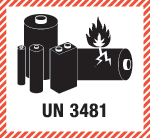Important! The proper application of the products listed in the catalog require professional know-how. In particular knowledge (or experience in the application) of the standards (e.g., DIN / ISO) cited in this catalogue is required.
Notes on use
In spite of all precautions, residual risks remain. Some of these potential, not obvious hazards are explained below (list not exhaustive).
Fasteners ≥ 10.9 and case-hardened with electroplated coatings: Risk of hydrogen embrittlement!
Reduction of the risk of hydrogen embrittlement (ISO 4042)
In case of galvanically-finished connecting elements made of steel with hardness ≥ 360 HV, that are under tensile stress, there is a risk of failure due to hydrogen embrittlement.
A heat treatment (baking) of the parts, e.g. following acid pickling or after metal coating, reduces the risk of breakage. However, it cannot be guaranteed that the risk of hydrogen embrittlement will be removed completely.
If the risk of hydrogen embrittlement must be reduced, then other coating procedures should be considered. Alternative methods of corrosion protection or coating should therefore be selected for parts which are important to safety, alternatives such as an organic zinc coating, mechanical zinc plating or a switch to stainless- and acid-resistant steel.
Spring elements ≥ 360 HV electroplated coatings: Risk of hydrogen embrittlement!
To the extent that manufacturing technology allows it, spring elements with anorganic coating or mechanical zinc plating can also be provided. If the possibility of hydrogen embrittlement is to be reduced, these coating processes should be taken into consideration.
Fasteners made of martensitic chrome steels: Stress corrosion can occur!
The proper use of martensitic chrome steels
(e.g., 1.4110, 1.4116, 1.4122 modified martensitic materials, ...) Martensitic Cr-steels differ from austenitic Cr-steels in their higher hardness and strength requirements. Usual fields of application are washers and self-cutting screws. Functional failure can be caused by stress corrosion or brittle fracture due to hydrogen absorption. Austenitic steels are preferred, if these materials are used in very aggressive ambient conditions, e.g., maritime climate, high humidity, use of detergents, high ambient temperatures and corrosive gases. In addition, martenisitic steels are less corrosion-resistant than austenitic Cr-Ni steels.
Correct handling, transport and use of chemical products and battery-operated products requires a knowledge of the applicable laws.
Hazardous substances require special measures for ensuring people and environmental protection. Contact with eyes, skin or mucous membranes must be avoided when processing chemical-technical products. It is recommended to wear protective goggles and safety gloves. Eye showers should be provided as well. The vapors produced during the processing should not be inhaled for a long time or in high concentration. Adequate ventilation of the workplace has to be ensured. The indicated mixing ratio must be closely observed. Corresponding labelling of the product and the appropriate documentation facilitate the correct use. For toxic products: It is essential to take precautions and note warnings on the packages. Hand over used or damaged batteries to an official collection point.
Transports are usually carried out with the exemption according to ADR 1.1.3.6 (so-called “1,000 point limit” or also “LQ” limited quantity). The delivery document specifies handling.
Observe the safety data sheets provided by the product manufacturer and strictly comply with the precautionary measures described therein!
Transport instructions in EU/CH:
The recommended Li-ion batteries are subject to the requirements of dangerous goods legislation. The batteries can be transported by the user by road without any further requirements.
When shipping by third parties (e.g. air transport or freight forwarders), special packaging and labeling requirements must be observed. A dangerous goods expert must be consulted when preparing the package.
Only ship rechargeable batteries if the housing is undamaged. Tape off open contacts and pack the battery so that it cannot move in the packaging. Please observe the labeling and packaging requirements. A dangerous goods expert must be consulted when preparing the package.
Only ship rechargeable batteries if the housing is undamaged. Tape open contacts and pack the battery in such a way that it does not move in the packaging. Please also observe any additional national regulations.
EU market requirement
According to the European Directive 2012/19/EU on waste electrical and electronic equipment and its transposition into national law, power tools that are no longer fit for use and, according to the European Directive 2006/66/EC, defective or used rechargeable batteries/batteries must be collected separately and recycled in an environmentally sound manner.
If disposed of improperly, waste electrical and electronic equipment can have harmful effects on the environment and human health due to the possible presence of hazardous substances.
Warning hazardous
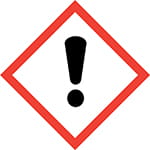 Typical properties
Typical properties
May cause respiratory irritation. May cause drowsiness or dizziness. May cause an allergic skin reaction. Causes serious eye irritation. Causes skin irritation. Can cause poisoning after single exposure. Harms public health and the environment by destroying ozone in the upper atmosphere.
Measures
Avoid skin contact. Use only the required amount. Seal carefully after use.
Flammable
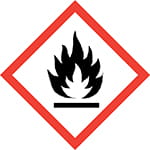 Typical properties
Typical properties
Can ignite from contact with flames or sparks through shock, friction, heat, air- or water contact. Can ignite itself due to incorrect storage without any external influence.
Measures
Avoid sources of ignition. Have ready suitable extinguishing media. Observe storage temperature. Seal carefully after use.
Oxidising
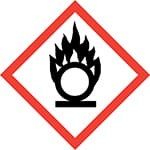 Typical properties
Typical properties
May cause or intensify fire (oxidizer). May cause fire or explosion (strong oxidizer). Releases oxygen and the fire can therefore only be extinguished with special extinguishing agents. Smothering the flame is impossible.
Measures
Keep away from heat/sparks/open flames/hot surfaces. No smoking. Keep away from combustible material. Have ready suitable extinguishing media. Seal carefully after use.
Explosive
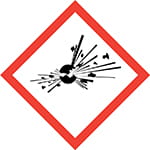 Typical properties
Typical properties
Can explode from contact with flames or sparks through shock, friction or heat. Can explode due to incorrect storage without any external influence.
Measures
Should only be applied by proffessionals or trained staff. Observe ambient air temperature during storage and application. Seal carefully after use.
Gas under pressure
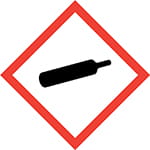 Typical properties
Typical properties
Contains compressed, liquefied or dissolved gases. Odorless or invisible gases can escape unnoticed. Containers with compressed gases my rupture from heat or deformation.
Measures
Protect from sunlight. Store in a well ventilated place (not in the basement!) Seal carefully after use.
Hazardous to the environment
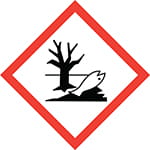 Typical properties
Typical properties
Toxic or very toxic to aquatic life (fish, aquatic insects, water plants) with acute or long lasting effects.
Measures
Note the risk and safety notes on the label. Follow the instructions and dosing regimes. Avoid release into the environment and collect spillage. Return product and partially emptied cartridges to the point of sale or dispose of as hazardous waste.
Corrosive
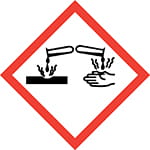 Typical properties
Typical properties
Causes severe skin burns and eye damage. Can dissolve certain materials (e.g. textiles). Is harmful to animals, plants and organic material of all kinds.
Measures
Always wear protective gloves and eye protection. Seal carefully after use.
Harmful to health
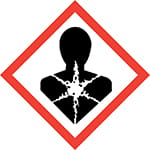 Typical properties
Typical properties
May cause damage to organs. May lead to immediate and long-term massive impairment of health. May cause cancer. May damage the genetic, fertility or the unborn child. May be fatal if swallowed and enters airways.
Measures
Do NOT swallow. If swallowed: immediately call a POISON CENTER or a doctor/physician. Do NOT induce vomiting. Avoid unnecessary contact. Consider long-term damage. Seal carefully after use.
Acute toxicity
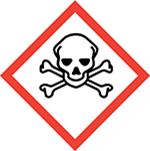
Typical properties
Fatal if swallowed. Fatal in contact with skin. Fatal if inhaled. Even small amounts can cause severe poisoning and death.
Measures
Use with extreme caution. Wear protective gloves/protective clothing/eye protection/face protection. Exclude the risk for third parties. Seal carefully after use.
UL Listed Product
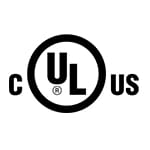
Globally recognized quality certification by:
Underwriters Laboratories Inc.
Explanation
Samples of this product have been tested by UL and confirmed their compliance with the safety requirements according to UL.
UL Recognized Component
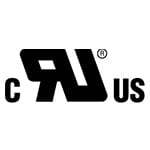
Globally recognized quality certification by:
Underwriters Laboratories Inc.
Explanation
The recognized UL component may be used in a product or system that bears the UL Listing Mark.
Approval mark VDE
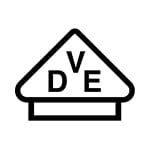
Globally recognized quality certification by:
VDE Verband der Elektrotechnik Elektronik Informationstechnik e.V. (Association for Electrical, Electronic & Information Technologies)
Explanation
VDE represents German interests within the European Committee for Electrotechnical Standardization (CENELEC) and the International Electrotechnical Commission (IEC).
Certification mark DNV GL
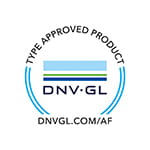
Globally recognized quality certification by:
DNV GL, SE, Hamburg, Germany
Explanation
The DNV-GL type approval is a procedure that confirms compliance with rules for standard designs and / or routinely manufactured, identical components. Products and components listed in the DNV-GL approval register are preferred in the maritime, oil, gas and energy industries.
Mark of conformity DNV-GL
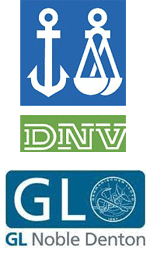 Worldwide recognized quality certification by:
Worldwide recognized quality certification by:
DNV (Det Norske Veritas)
Explanation
DNV is the world's leading classification society for the maritime industry. It provides globally recognized testing, certification and technical consultancy services for the energy value chain, including renewable energy, oil and gas, and energy management.
Mark of conformity RINA
 Quality certification recognized worldwide by:
Quality certification recognized worldwide by:
RINA (Registro Italiano Navale)
Explanation
Registro Italiano Navale (RINA) is a ship classification society and is mainly involved in technical survey and classification of ships. Other business areas are technical certification and risk management in the fields of transport and infrastructure.
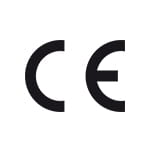
Responsibility:
European Union
The CE marking serves as proof that a product meets the basic health and safety requirements under EU law, and that the necessary conformity assessment procedures have been performed. Present CE markings are only shown in the catalog if the distinction between products makes sense. The mandatory CE mark is placed on the particular product packaging or on the product itself.
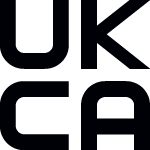 The UKCA marking is the conformity marking for products placed on the market in the United Kingdom (England, Scotland and Wales). The UKCA scheme has been in force since January 1, 2021. From this date, product with compliance with the relevant requirements can be marked with a UKCA mark.
The UKCA marking is the conformity marking for products placed on the market in the United Kingdom (England, Scotland and Wales). The UKCA scheme has been in force since January 1, 2021. From this date, product with compliance with the relevant requirements can be marked with a UKCA mark.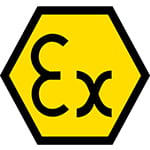
The explosion protection is the engineering sector that deals with the protection against the development of explosions and their effects.
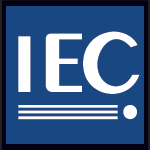
IEC certification ensures that products meet specific safety, performance and quality standards and are therefore suitable for their intended use.

Responsibility:
German Institut for Building Technology DIBT, Berlin

Operating Manual
Read the operating instructions with the safety and operating information and the technical data. Failure to observe the safety information and instructions may result in electric shock or fire. Serious injury and environmental damage may result. The associated operating instructions with CE declaration of conformity are part of the product delivery.
 Battery Recycling: Hand over used batteries to a collection point. Battery recycling is subject to the respective national legal requirements. Lithium batteries and lithium-ion batteries are hazardous goods !
Battery Recycling: Hand over used batteries to a collection point. Battery recycling is subject to the respective national legal requirements. Lithium batteries and lithium-ion batteries are hazardous goods !
Suitable for railway applications concerning fire protection in rail vehicles and public facilities. Product requirements according to EN 45545 fire testing of materials and components.
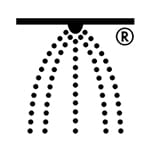
Recognised for use in local/waterbased fire extinguisher systemsVdS (Schadenverhütung GmbH)
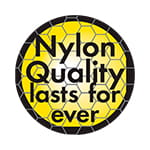
Nylon quality PA 6, certified plug material

Fire resistance test certification
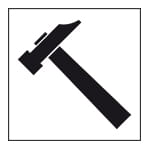
Assembly with manual hammering
Assembly with mechanical hammering device

